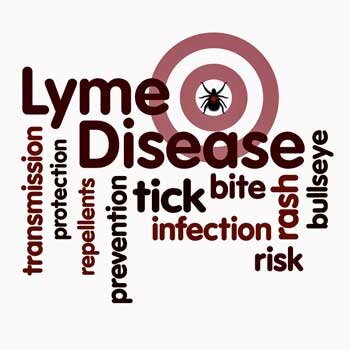Researchers Closing in on Definitive Lyme Tests As NIH Amps Up Lyme Efforts
It wasn't until 1983 that Borrelia burgdorfii, a bacteria carried by the black-legged or deer ticks, was identified as the cause of Lyme disease. That didn't mean a good diagnostic test has been available - far from it.None of the currently available tests (PCR, antibodies) are anything near definitive. PCR tests often fail when they simply miss the low numbers of bacteria present. The most commonly used tests, antibody tests, on the other hand, don't begin to be accurate until a month or more into the disease.That's not a good scenario for a person bitten by a tick who needs a quick regimen of antibiotics to ward off the potential joint, connective tissue, heart and nervous system complications that can occur, 20-30% of whom never get the infamous Lyme rash. Public health authorities estimate that as many 300,000 people are exposed to Lyme disease every year - but only 30,000 cases are reported. The current tests are so problematic that health officials in areas with high rates of Lyme disease often simply provide prophylactic doses of antibiotics to anyone exposed to a tick who comes down with a fever, headache, etc.Plus people who remain ill after treatment, or who are diagnosed using controversial tests, can be given long term courses of antibiotics long term which carry their own risks. The number one thing that's wanted and needed in the Lyme world is an effective diagnostic test. The good news is that one may be on the horizon.The current slate of antibody tests were agreed upon back in 1993 at the Dearborn Conference when our understanding of Lyme disease was in its infancy. Twenty three years later, experts experienced in the clinical and laboratory aspects of Lyme and other infectious diseases met at the Cold Spring Harbor to discuss better Lyme diagnostic tests.That meeting and discussions afterward laid the basis for a 2019 Viewpoint article in the Journal of Clinical Infectious Diseases with the provocative title, "Direct Diagnostic Tests for Lyme Disease".
The current tests are so problematic that health officials in areas with high rates of Lyme disease often simply provide prophylactic doses of antibiotics to anyone exposed to a tick who comes down with a fever, headache, etc.Plus people who remain ill after treatment, or who are diagnosed using controversial tests, can be given long term courses of antibiotics long term which carry their own risks. The number one thing that's wanted and needed in the Lyme world is an effective diagnostic test. The good news is that one may be on the horizon.The current slate of antibody tests were agreed upon back in 1993 at the Dearborn Conference when our understanding of Lyme disease was in its infancy. Twenty three years later, experts experienced in the clinical and laboratory aspects of Lyme and other infectious diseases met at the Cold Spring Harbor to discuss better Lyme diagnostic tests.That meeting and discussions afterward laid the basis for a 2019 Viewpoint article in the Journal of Clinical Infectious Diseases with the provocative title, "Direct Diagnostic Tests for Lyme Disease".
Direct Diagnostic Tests for Lyme Disease
Direct Diagnostic Tests for Lyme Disease Steven E Schutzer Barbara A Body Jeff Boyle Bernard M Branson Raymond J Dattwyler Erol Fikrig Noel J Gerald Maria Gomes-SoleckiMartin Kintrup Michel Ledizet ... Show more Clinical Infectious Diseases, Volume 68, Issue 6, 15 March 2019, Pages 1052–1057, https://doi.org/10.1093/cid/ciy614The Viewpoint effort was lead by Stephen Schutzer - an immunologist and sometime ME/CFS researcher - who in 2011 used an analysis of proteins in the cerebral spinal fluid to distinguish post-treatment Lyme disease from chronic fatigue syndrome (ME/CFS).The authors got right to the point: the serologic tests presently used, they wrote, "cannot distinguish active infection, past infection, or reinfection". "Reliable direct-detection methods, on the other hand, now appear achievable".It should be noted that the scientific advances allowing such statements to be made provide hope not just for Lyme disease patients but for those with other difficult-to-detect infections. Reliable diagnostic tests have recently been developed quickly for a number of newly emerging diseases such as Middle East respiratory syndrome – coronavirus, Zika infection, and even 2 newly recognized tick-borne borrelia infections (Borrelia mayonii, Borrelia miyamotoi).B. burgdorfii is a different case, however. Three factors in its makeup (low bacterial load, high antigenic diversity and a wacky genome) have made it particularly difficult to capture.Antigen CaptureInstead of directly looking for the bacteria itself, it's possible to look for the antigens (proteins) the bacteria sloughs off into the blood, urine, etc. Past antigen capture efforts have been thrown off by the high antigenic variability found in the Lyme bacteria but new developments in mass spectrometry, and antigen enrichment and stabilization are making antigen capture a real possibility for capturing B. burgdorfii. A Better PCR B. burgdorfii's second trick for evading capture - low bacterial loads in the blood - have made it difficult to capture by PCR. Enter high-throughput sequencing techniques that have been developed to scan larger blood samples. Frequently used to detect exotic infections, the authors asserted these techniques can "be applied successfully to Lyme disease diagnostics".They know - because they've done them. These tests, which are 200 times more sensitive than normal PCR, may just be the tip of the iceberg, though. Adding other measures to their Lyme test kit allowed the authors to increase the sensitivity of their PCR a jaw-dropping 16,000 fold - enabling them to catch many more cases of Lyme disease than had been previously detected.Instead of the .5 ml of plasma usually taken, the authors took 1.25 ml of whole blood, used a technique to amplify the bacteria present, and then used multiple primers.Next Generation SequencingB. burgdorfii's third evasive maneuver - its complex and unusual genome consisting of high levels of circular plasmids - has enabled it to evade capture in the past, but the development of a new technique ("long-read sequencing") has allowed Pacific Bioscience to uncover hallmark sequences of the bug's genome that can conceivably be targeted in diagnostic tests.Serology Not Dead YetSerological testing, which relies on assessing the immune response to the bug, has a couple of problems, but doctors are familiar with serological testing and it may be cheaper and easier to use than other techniques. Improved serological testing could clearly provide a boon as well.Just a week ago, a biomedical engineering group from Columbia published a study using a new serological test which purportedly can diagnose a Lyme infection in just 15 minutes. This test which uses "microfluidics" was much more effective than the standard tests at diagnosing early infections. The test needs to be further refined and tested, but the early results were good.Effective Lyme Test Now Technically PossibleThe advances enabled the authors to assert that "the goal of an active-infection diagnostic test is now technically achievable". Note the word "technically". We're not there yet.Understanding the full breadth of B. burgdorfii's genetic diversity, creating better genomic databases, optimizing sample collection procedures and other issues need to be resolved for that to happen. That's all a matter of funding; i.e. the political will to get the Lyme (and other tick-borne illnesses) under control.
B. burgdorfii's second trick for evading capture - low bacterial loads in the blood - have made it difficult to capture by PCR. Enter high-throughput sequencing techniques that have been developed to scan larger blood samples. Frequently used to detect exotic infections, the authors asserted these techniques can "be applied successfully to Lyme disease diagnostics".They know - because they've done them. These tests, which are 200 times more sensitive than normal PCR, may just be the tip of the iceberg, though. Adding other measures to their Lyme test kit allowed the authors to increase the sensitivity of their PCR a jaw-dropping 16,000 fold - enabling them to catch many more cases of Lyme disease than had been previously detected.Instead of the .5 ml of plasma usually taken, the authors took 1.25 ml of whole blood, used a technique to amplify the bacteria present, and then used multiple primers.Next Generation SequencingB. burgdorfii's third evasive maneuver - its complex and unusual genome consisting of high levels of circular plasmids - has enabled it to evade capture in the past, but the development of a new technique ("long-read sequencing") has allowed Pacific Bioscience to uncover hallmark sequences of the bug's genome that can conceivably be targeted in diagnostic tests.Serology Not Dead YetSerological testing, which relies on assessing the immune response to the bug, has a couple of problems, but doctors are familiar with serological testing and it may be cheaper and easier to use than other techniques. Improved serological testing could clearly provide a boon as well.Just a week ago, a biomedical engineering group from Columbia published a study using a new serological test which purportedly can diagnose a Lyme infection in just 15 minutes. This test which uses "microfluidics" was much more effective than the standard tests at diagnosing early infections. The test needs to be further refined and tested, but the early results were good.Effective Lyme Test Now Technically PossibleThe advances enabled the authors to assert that "the goal of an active-infection diagnostic test is now technically achievable". Note the word "technically". We're not there yet.Understanding the full breadth of B. burgdorfii's genetic diversity, creating better genomic databases, optimizing sample collection procedures and other issues need to be resolved for that to happen. That's all a matter of funding; i.e. the political will to get the Lyme (and other tick-borne illnesses) under control.
New NIH Emphasis on Lyme Disease
Finally, in a last bit of good news - the NIH will be ploughing more resources into Lyme research over the next five years.Lyme disease has differed little from ME/CFS, fibromyalgia and others in its neglect at the NIH, and new NIH emphasis on Lyme was the result of years of advocacy work. In some ways, ME/CFS advocacy is on a parallel track - it's just a few years behind. A Congressional Lyme Disease Caucus,led by two Lyme champions, and that was officially formed in 2013, paved the way. The 2016 21st Century Cures Act mandated the establishment of the Tick-Borne Diseases Working Group the NIH. In 2018, that group produced a report outlining recommendations for research which included increasing funding, improving diagnostics and, more importantly, developing a strategic plan.That plan was recently published, and when it was, Rep. Chris Smith, one of the leaders of the Lyme Caucus, and a long time advocate for more Lyme research, reported advocacy efforts had paid off:
The 2016 21st Century Cures Act mandated the establishment of the Tick-Borne Diseases Working Group the NIH. In 2018, that group produced a report outlining recommendations for research which included increasing funding, improving diagnostics and, more importantly, developing a strategic plan.That plan was recently published, and when it was, Rep. Chris Smith, one of the leaders of the Lyme Caucus, and a long time advocate for more Lyme research, reported advocacy efforts had paid off:
“After lagging for decades, NIH is all in for researching Lyme and other tick-borne diseases to better diagnose and treat those suffering from this horrific disease. This is great news for patients and Lyme-literate doctors who will now have serious, federal partners working aggressively to improve strategies for the detection, treatment, and one day, prevention of Lyme.”
That plan includes a number of intriguing focii, including determining the cause of an ME/CFS-like disease (post-treatment Lyme disease syndrome), better understanding the only known food allergy that can be induced by an insect bite (alpha gal syndrome), and developing rapid and direct detection diagnostic tests as well as vaccines and immune-based treatments.Lyme isn't the only neglected disease benefiting from effective advocacy. The money the HEAL project is pumping into efforts at the NIH to fight the opioid epidemic and create better pain drugs resulted from a public outcry. ME/CFS, with its ramp-up of advocacy efforts, and the NIH's work on a strategic plan, is hopefully following a similar path as Lyme disease.See- Did a Pivotal Moment for ME/CFS Just Happen?Smith is not nearly done with Lyme advocacy. His next trick is a bill (TICK Act (HR 3073) that would create a national strategy to prevent and treat Lyme and similar diseases.
Conclusion
Rapidly decreasing technological costs are helping the search for better diagnostic tests. More work needs to be done, though, to validate a test and bring it to market.The takeaway message from the Direct Diagnosis paper is that we now have the technology needed to develop a reliable, effective test for Lyme disease. Such a test would identify many people who don't know they have the disease and stop unneeded treatment in those who don't have it. It should also help us understand what's going on in those who have been treated and remain ill (post-treatment Lyme Disease).The missing element has been the political will to comprehensively tackle the disease and provide the necessary research funding.That appears to be changing as well. Years of advocacy paid off with the recent production of a strategic plan to comprehensively fight Lyme disease. The NIH's new emphasis should further advance the development of better diagnostic tests and, hopefully create new treatment possibilities. With ME/CFS on a similar path with it's own strategic plan being developed, it'll be illuminating to see how much Lyme disease funding shoots up over the next couple of years.More on Lyme Disease From Simmaronhttp://simmaronresearch.com/2018/09/post-treatment-lyme-disease-unmasked-immune-holes/
